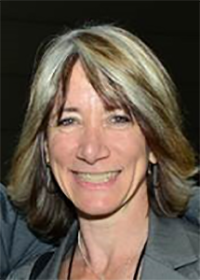Experts from around the world are coming together to develop ideas for the future.
Professor Elise Miller-Hooks

Professor Elise Miller-Hooks organized the Mason Engineering symposium, Imagine the Future 2017.
Imagine a world where roads, water pipelines, and power networks are woven seamlessly into the built environment. The systems are resilient, sustainable, and secure, and offer services that improve people’s well-being.
“We are at the cusp of a new future, and we need to think about how we might do things differently.” says Professor Elise Miller-Hooks, the Bill and Eleanor Hazel Chair in Infrastructure Engineering. The time is right to consider how to best use the current infrastructure systems and to rethink how to build them from now on.
To tackle this important topic, Miller-Hooks has organized the Mason Engineering symposium, Imagine the Future 2017: Conceptualizing Infrastructure Systems for an Interconnected World. It’s being held Sunday, October 8, and Monday, October 9 at George Mason University.
The symposium will connect about 50 leading experts from across the United States and around the world who will attend the event to discuss their ideas for new ways to create, design, operate, and control infrastructure systems.
Among those attending are representatives from the Department of Homeland Security, the U.S. Department of Transportation, U.S. Geological Survey, the National Science Foundation, U.S. Navy, Army Corps of Engineers, the American Society of Civil Engineers, and the Society of Military Engineers.
Participants also come from industry, academia, and community-based organizations. They hail from six different countries. Their expertise aids in shaping, maintaining, and protecting the built environment.
“Experts from around the world are coming together to develop ideas for the future,” Miller-Hooks says. She encourages attendees to think creatively and challenge established norms.
Her rules for Monday’s sessions include the “No” Rules: No bystanders. No sitting at the same chair all day, and the “Yes” Rules: Think big. Think small. Think sideways and upside down. Go futuristic. Go backward in time. Ridiculous ideas may lead to something novel, so be ridiculous.
The event kicks off Sunday at 6 p.m. with dinner at George’s in the Johnson Center. Thomas Bock, a professor of building realization and robotics from the Technical University of Munich, will be the keynote speaker.
The workshops on Monday include discussions, visionary lectures, and demonstrations about emerging technologies, a world without borders, multipurpose infrastructure, and space-age construction.
At the end of the day, small groups will create proposals for the final discussion. Then symposium participants will work together on one symposium-wide outcome.
Rashin Kheiriyeh, an Iranian-American author/illustrator, will create the illustration for the final report and poster.
For more information, visit the symposium website.
